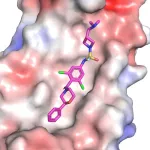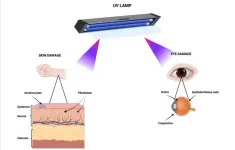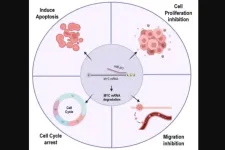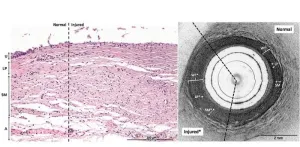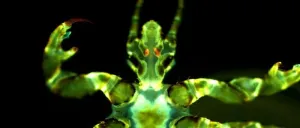(Press-News.org) LA JOLLA, CA—Currently available flu medications only target the virus after it has already established an infection, but what if a drug could prevent infection in the first place? Now, scientists at Scripps Research and the Albert Einstein College of Medicine have designed drug-like molecules to do just that, by thwarting the first stage of influenza infection.
The drug-like inhibitors block the virus from entering the body’s respiratory cells—specifically, they target hemagglutinin, a protein on the surface of type A influenza viruses. The findings, published in the Proceedings of the National Academy of Sciences on May 16, 2024, represent an important step forward in developing a drug that can prevent influenza infection.
“We’re trying to target the very first stage of influenza infection since it would be better to prevent infection in the first place, but these molecules could also be used to inhibit the spread of the virus after one's infected,” says corresponding author Ian Wilson, DPhil, the Hansen Professor of Structural Biology at Scripps Research.
The inhibitors will need to be further optimized and tested before they can be assessed as antivirals in humans, but the researchers say that these molecules ultimately have the potential to help prevent and treat seasonal flu infections. And, unlike vaccines, the inhibitors likely wouldn’t need to be updated yearly.
The researchers had previously identified a small molecule, F0045(S), with a limited capacity to bind and inhibit H1N1 type A influenza viruses.
“We began by developing a high-throughput hemagglutinin binding assay that allowed us to rapidly screen large libraries of small molecules and found the lead compound F0045(S) with this process,” says corresponding author Dennis Wolan, PhD, senior principal scientist at Genentech and former associate professor at Scripps Research.
In this study, the team aimed to optimize F0045(S)’s chemical structure to design molecules with better drug-like properties and more specific binding ability to the virus. To start, the Wolan lab used “SuFEx click-chemistry,” which was first developed by two-time Nobel laureate and co-author K. Barry Sharpless, PhD, to generate a large library of candidate molecules with various tweaks to F0045(S)’s original structure. When they screened this library, the researchers identified two molecules—4(R) and 6(R)—with superior binding affinity compared to F0045(S).
Next, Wilson’s lab produced X-ray crystal structures of 4(R) and 6(R) bound to the flu hemagglutinin protein so that they could identify the molecules’ binding sites, determine the mechanisms behind their superior binding ability, and identify areas for improvement.
“We showed that these inhibitors bind much more tightly to the viral antigen hemagglutinin than the original lead molecule did,” says Wilson. “By using click-chemistry, we basically extended the compounds’ ability to interact with influenza by making them target additional pockets on the antigen surface.”
When the researchers tested 4(R) and 6(R) in cell culture to verify their antiviral properties and safety, they found 6(R) was non-toxic and had more than 200-times improved cellular antiviral potency compared to F0045(S).
Finally, the researchers used a targeted approach to further optimize 6(R) and develop compound 7, which proved to have even better antiviral ability.
“This is the most potent small-molecule hemagglutinin inhibitor developed to date,” says corresponding author Seiya Kitamura, who worked on the project as a postdoctoral fellow at Scripps Research and is now an assistant professor at the Albert Einstein College of Medicine.
In future studies, the team plans to continue to optimize compound 7 and to test the inhibitor in animal models of influenza.
“In terms of potency, it will be hard to improve the molecule any further, but there are many other properties to consider and optimize, for example, pharmacokinetics, metabolism and aqueous solubility,” says Kitamura.
Because the inhibitors developed in this study only target H1N1 strains of influenza, researchers are also working to develop equivalent drug-like inhibitors to target other strains of influenza such as H3N2 and H5N1.
In addition to Wilson, Wolan, Sharpless, and Kitamura, authors of the study, “Ultrapotent influenza hemagglutinin fusion inhibitors developed through SuFEx-enabled high-throughput medicinal chemistry” include Ting-Hui Lin, Chang-Chun David Lee, Akihiro Takamura, Rameshwar Kadam, Ding Zhang, Xueyong Zhu, Wenli Yu, and Yao Yao of Scripps Research; and Lucas Dada, Emiko Nagai of Albert Einstein College of Medicine
This work was supported by the NIH, the Nathan Shock Institute of Aging Research, and Einstein-Montefiore.
About Scripps Research
Scripps Research is an independent, nonprofit biomedical institute ranked one of the most influential in the world for its impact on innovation by Nature Index. We are advancing human health through profound discoveries that address pressing medical concerns around the globe. Our drug discovery and development division, Calibr-Skaggs, works hand-in-hand with scientists across disciplines to bring new medicines to patients as quickly and efficiently as possible, while teams at Scripps Research Translational Institute harness genomics, digital medicine and cutting-edge informatics to understand individual health and render more effective healthcare. Scripps Research also trains the next generation of leading scientists at our Skaggs Graduate School, consistently named among the top 10 US programs for chemistry and biological sciences. Learn more at www.scripps.edu.
END
Drug-like inhibitor shows promise in preventing flu
Scripps Research scientists have developed a potential drug-like molecule that blocks the first stage of type A influenza infection.
2024-05-21
ELSE PRESS RELEASES FROM THIS DATE:
Study finds widespread ‘cell cannibalism,’ related phenomena across tree of life
2024-05-21
In a new review paper, Carlo Maley and Arizona State University colleagues describe cell-in-cell phenomena in which one cell engulfs and sometimes consumes another. The study shows that cases of this behavior, including cell cannibalism, are widespread across the tree of life.
The findings challenge the common perception that cell-in-cell events are largely restricted to cancer cells. Rather, these events appear to be common across diverse organisms, from single-celled amoebas to complex multicellular animals.
The widespread occurrence of such interactions in non-cancer cells suggests that these events are not inherently "selfish" or "cancerous" ...
Germicidal lamps using UV-C radiation may pose health safety issues
2024-05-21
“Despite the potential advantages of utilizing UV-C radiation for deactivating pathogens such as SARS-CoV-2, the prevailing conclusion remains that UV-C radiation poses concurrent risks to human health.”
BUFFALO, NY- May 21, 2024 – A new research paper was published in Aging (listed by MEDLINE/PubMed as "Aging (Albany NY)" and "Aging-US" by Web of Science) Volume 16, Issue 9, entitled, “Germicidal lamps using UV-C radiation may pose health safety issues: a biomolecular analysis of their effects on apoptosis and senescence.”
The battle against the COVID-19 pandemic has spurred a heightened state of vigilance in global healthcare, ...
Inhibitory effect of miR-377 on prostate cancer cells
2024-05-21
“Our research findings suggest that miR-377 could potentially serve as a valuable therapeutic strategy for the treatment of prostate cancer (PCa).”
BUFFALO, NY- May 21, 2024 – A new research paper was published in Genes & Cancer on May 16, 2024, entitled, “Inhibitory effect of miR-377 on the proliferative and invasive behaviors of prostate cancer cells through the modulation of MYC mRNA via its interaction with BCL-2/Bax, PTEN, and CDK4.”
The MYC gene is a regulatory and proto-oncogenic gene that is overexpressed in the majority of prostate cancers (PCa). Numerous studies have indicated that aberrant expression of microRNAs is involved in the ...
Innovative imaging technique may revolutionize ureteral thermal injury detection
2024-05-21
In a groundbreaking study, scientists have explored a novel approach to detect electrothermal ureteral injuries, a common complication during pelvic surgery. The ureters, delicate tubes that transport urine from the kidneys to the bladder, are particularly vulnerable due to their proximity to other anatomical structures. Unfortunately, current detection methods often fall short in promptly identifying subtle thermal injuries, which can take days or even weeks to manifest.
Enter optical coherence tomography ...
Conservation of nature’s strongholds needed to halt biodiversity loss
2024-05-21
To achieve global biodiversity targets, conservationists and governments must prioritize the establishment and effective management of large, interconnected protected areas with high ecological integrity, John G. Robinson from the Wildlife Conservation Society, US, and colleagues argue in an essay publishing May 21st in the open-access journal PLOS Biology.
The Kunming–Montreal Global Biodiversity Framework (GBF), signed at the 2022 Conference of Parties to the UN Convention on Biological Diversity in Montreal, recognized the importance of protecting large areas of natural habitat to maintain the resilience and integrity of ecosystems. To halt biodiversity ...
Body lice may be bigger plague spreaders than previously thought
2024-05-21
A new laboratory study suggests that human body lice are more efficient at transmitting Yersinia pestis, the bacterium that causes plague, than previously thought, supporting the possibility that they may have contributed to past pandemics. David Bland and colleagues at the United States’ National Institute of Allergy and Infectious Diseases present these findings in the open-access journal PLOS Biology on May 21st.
Y. pestis has been the culprit behind numerous pandemics, including the Black Death of the Middle Ages that ...
Gun violence touches nearly 60 percent of Black Americans – and predicts disability
2024-05-21
Roughly 60 percent of all Black Americans are exposed to some form of gun violence, and such exposures predict elevated rates of disability, according to Rutgers Health research.
Survey data from 3,015 Black Americans linked specific disabilities ranging from trouble concentrating to difficulty dressing or bathing with exposure to various types of gun violence: being shot, being threatened with a firearm, knowing a shooting victim, and witnessing a shooting or hearing of one nearby.
“Traditionally, the majority of efforts related to gun violence have focused on reducing homicides, but this study indicates that we need ...
A rise in sea urchins and related damage to kelp forests impacts Oregon’s gray whales and their food
2024-05-21
NEWPORT, Ore. – A recent boom in the purple sea urchin population off the southern Oregon Coast appears to have had an indirect and negative impact on the gray whales that usually forage in the region, a new study shows.
When urchin numbers rise, the spiky marine invertebrates can devour kelp forests that are a critical habitat for zooplankton, the tiny aquatic organisms that are the primary prey of many marine animals. Damaged kelp forests lead to reductions in zooplankton, and with fewer zooplankton to feed on, gray whales spend less time foraging there, researchers with Oregon State University’s Marine Mammal Institute found.
“This study shows the cascading ...
Detroit researchers find connection between PFAS exposure in men and the health of their offspring
2024-05-21
DETROIT – Wayne State University researchers are reporting new findings that demonstrate a link between exposure to per- and polyfluorinated alkyl substances (PFAS) in males and health issues in their offspring.
The study, “Mixtures of per- and polyfluoroalkyl substances (PFAS) alter sperm methylation and long-term reprogramming of offspring liver and fat transcriptome,” published recently in Environment International, assessed the effect of PFAS mixtures on the sperm methylome and transcriptional changes in offspring metabolic tissues such as in the ...
Cosmic rays illuminate the past
2024-05-21
Researchers at the University of Bern have for the first time been able to pin down a prehistoric settlement of early farmers in northern Greece dating back more than 7,000 years to the year. For this they combined annual growth ring measurements on wooden building elements with the sudden spike of cosmogenic radiocarbon in 5259 BC. This provides a reliable chronological reference point for many other archaeological sites in Southeast Europe.
Dating finds plays a key role in archaeology. It is always essential to find out how old a tomb, settlement or single object is. Determining the age of finds from prehistoric times has only ...
LAST 30 PRESS RELEASES:
HKUST Engineering researchers developed a novel photodetector to enhance the performance of on-chip light monitoring
Strategic river sensors could have forewarned of Texas Camp flood disaster
Drone sampling of whale breath reveals first evidence of potentially deadly virus in Arctic
Roman soldiers defending Hadrian’s Wall infected by parasites, study finds
Pinochet’s prisoners were tormented with music but still found solace in it, a new book reveals
Fertility remains high in rural Tanzania despite access to family planning
AI-assisted device can improve autism care access
Kinetic careers
Uncovering how parasitic plants avoid attacking themselves to improve crop resistance
Nanoparticle vaccine strategy could protect against Ebola and other deadly filoviruses
Study finds brain care score can predict risk of stroke across racial groups
Key lung immune cells can intensify allergic reactions
Do hormones explain why women experience more gut pain?
New materials conduct ions in solids as easily as in liquids
Breakthrough of the Year: Renewable energy begins to eclipse fossil fuel-based sources
LLM use is reshaping scientific enterprise by increasing output, reducing quality and more
Introducing LightGen, a chip for ultra-fast, ultra-efficient generative AI
Astronomers see fireworks from violent collisions around nearby star
ACC/AHA issue new guideline on managing congenital heart disease in adults
Cosmic crash caught on camera
Is talented youth nurtured the wrong way? New study shows: top performers develop differently than assumed
Ants: An untapped resource in the development of antibiotics?
Archaeologists use AI to create prehistoric video game
Mitochondria migrate toward the cell membrane in response to high glucose levels
Tiny viral switch offers hope against drug-resistant bacteria
Most parents aware of early peanut introduction guidelines, but confused about details
HPV vaccine can protect against severe lesions of the vulva and vagina
Virtual care provision and emergency department use among children and youth
Quadrivalent HPV vaccine and high-grade vulvovaginal lesions
Insights into dry eyes gained from stem cell-derived tear glands
[Press-News.org] Drug-like inhibitor shows promise in preventing fluScripps Research scientists have developed a potential drug-like molecule that blocks the first stage of type A influenza infection.
